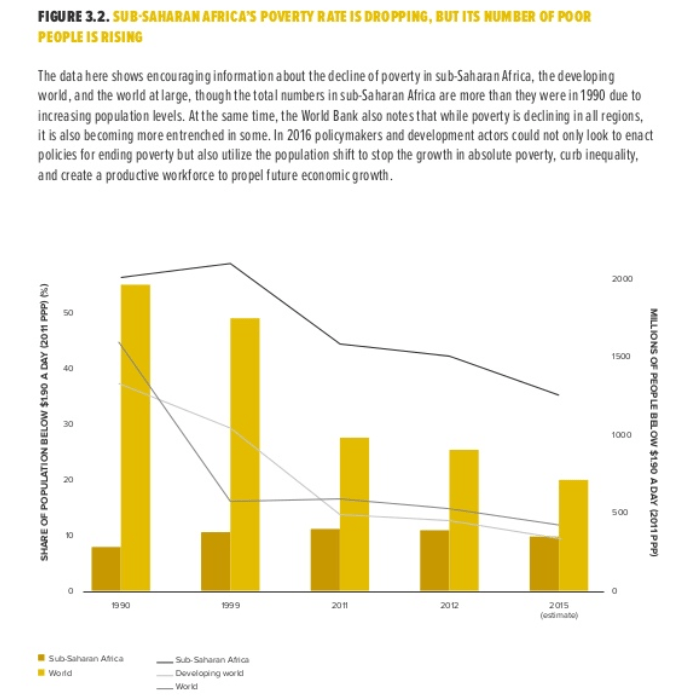In 2015, sub-Saharan Africa experienced its slowest economic growth rate since the 1998 global financial crisis. According to the IMF, the region’s real GDP growth fell from 5.0 percent in 2014 to 3.75 percent in 2015 and will rebound to 4.3 percent in 2016. Given recent global and regional trends, it is likely that the IMF will revise its 2016 sub-Saharan Africa growth forecast downward. Not all is lost, though: Changes like these create opportunities for appropriate and timely policy measures that can make a difference and help sub-Saharan African economies regain their growth momentum both in the short and long terms.
GDP per capita growth has averaged 3.4 percent in 2004-2014 but is now scheduled to fall to 1.4 percent in 2015 and hover around 1.9 percent in 2016. To put things in perspective, if the region was able to regain its 2004-2014 per capita GDP average growth rate, GDP per capita could be doubled in 20.5 years, by the year 2036. In contrast, at a growth rate of the predicted 1.4 percent, this achievement would take place in 50 years, by the year 2065.
There are different ways to look at the region’s vulnerabilities to current external shocks, and these ways all point to a regional economic slowdown:
• Oil and metal exporters in the region will experience slower growth. World Bank data indicate that fuel, metal, and mineral exports represent about 62 percent of sub-Saharan Africa’s exports in 2010-2014. Oil exporters, which include Angola, Cameroon, Chad, the Republic of the Congo, Equatorial Guinea, Gabon, Nigeria, and South Sudan alone represent about half of the region’s GDP and will be a drag on the region’s growth. In contrast, oil importing countries such as Ethiopia, Kenya, Rwanda, and Tanzania will help mitigate the impact of lower oil prices on the region.
- Growth in the largest economies in the region, Nigeria and South Africa, is slowing down. The two countries together account for more than half of the region’s GDP and have suffered from falling commodity prices as well as structural problems, including electricity shortages. Nigeria’s real GDP growth is expected to fall to 4.0 percent in 2015 from 6.3 percent in 2014 and recover to 4.3 percent in 2016. South Africa is expected to barely grow in 2015-2016, with a growth rate hovering around 1.4 percent.
• Economies that export the most to China are mostly commodity exporters and, as a result, are vulnerable to both a Chinese economic slowdown and lower commodity prices (the two trends are related). Exports to China from South Africa (the second-largest economy in the region) exceeded 29 percent of its total exports in 2010-2014 and are above 40 percent for a number of countries (the Gambia, the Democratic Republic of the Congo (DRC), the Republic of the Congo, Angola, Mauritania, and Sierra Leone). One of the best examples of a vulnerable country is Zambia, which is a major exporter of copper, most of which is sold to China (46 percent of Zambia’s exports in 2010-2014), the world’s largest consumer of the metal (45 percent of global demand in 2014).
